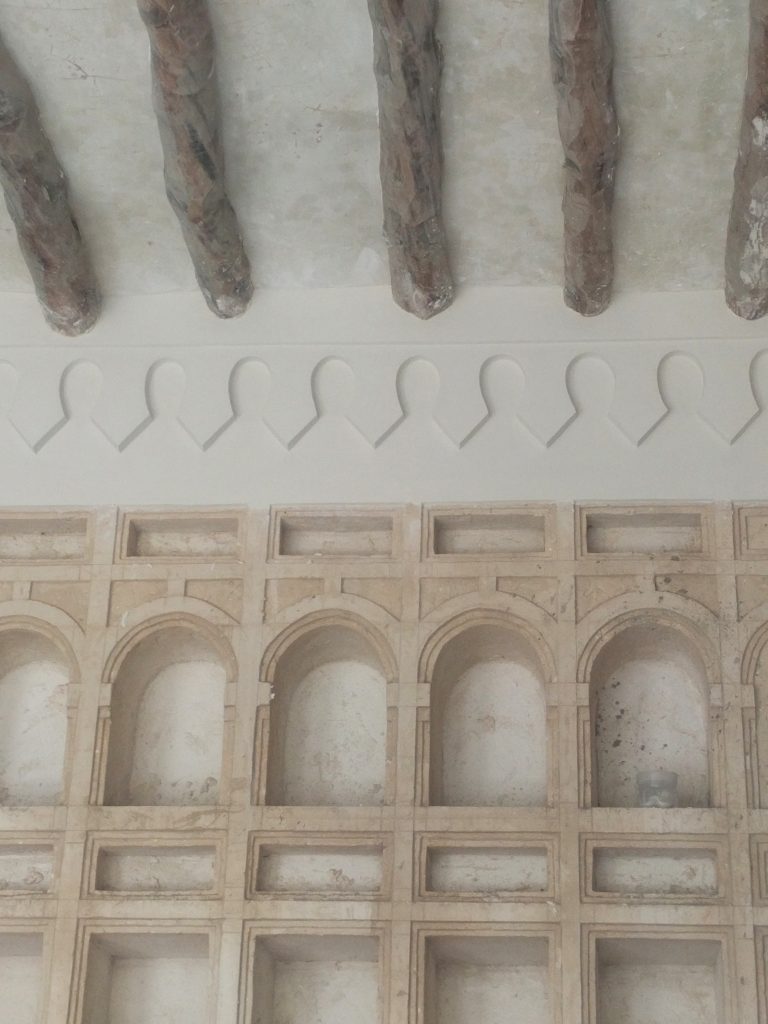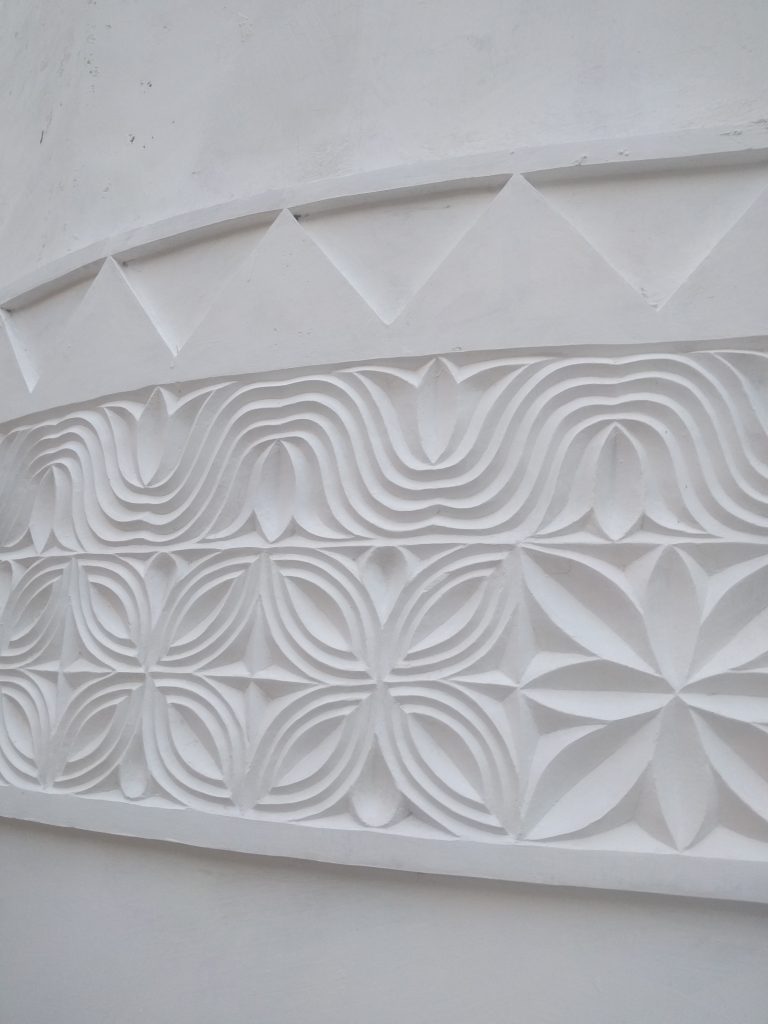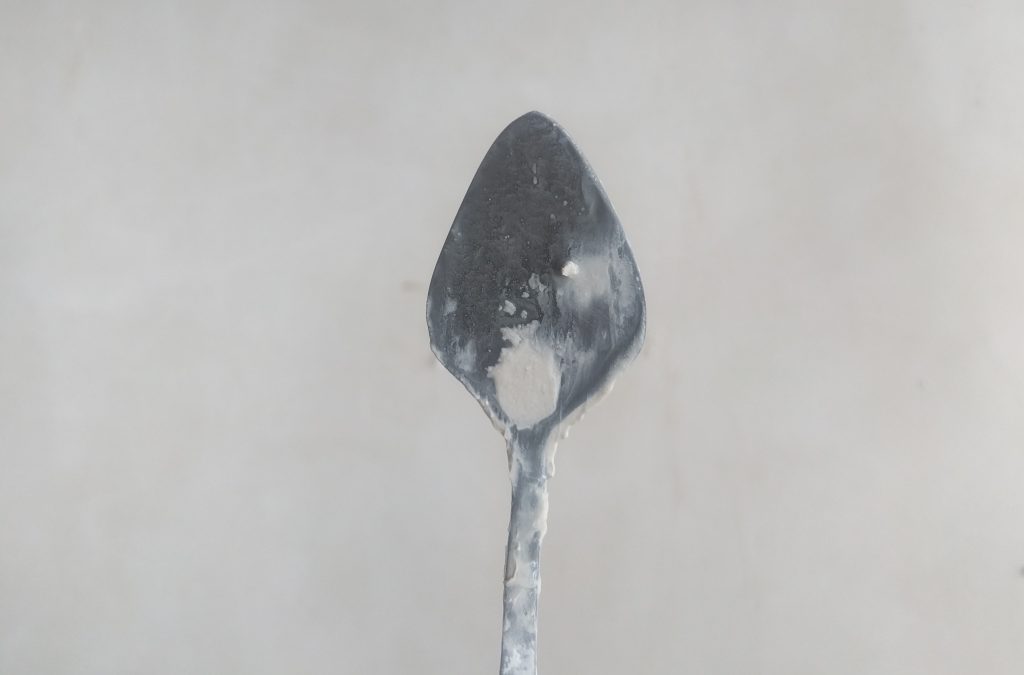Ahmed Yusuf Suleiman is one of the most sought-after Swahili plasterwork artists and a well-known building contractor on the East African coast. One afternoon in his hometown, Lamu, he gave me a tour of his ongoing contracts, describing the ancient methods that he’s mastered. The majority of his clients are wealthy European developers, some of who have made a hobby out of purchasing ancient upper-class properties and restoring them.

One of of the projects he showed me is a two-storey villa with bedrooms in the double-digits. The villa incorporated 17th and 18th century designs favoured by Swahili patricians of the time: wall niches, called vidaka, surrounded by intricately carved embellishments; dark mangrove wood running across the ceiling for support; and intricately carved wooden doors. His team built the entire structure, down to the shiny and slippery floor finish, using a composite that included the centuries-old, bank-breaking building favourite, limestone.
I was curious to know whether Ahmed, a Bajuni man born and raised in Lamu, built his own home using the methods he was known for.
“Mimi nimjengee mke wangu nyumba bila tiles? Hangekubali.”
Ahmed’s foreign clients favour aristocratic Swahili aesthetics from centuries past that emphasized the worldliness and material wealth of the Swahili coast. Local people, like Ahmed’s wife and her love for trendy and practical tiled floors, build homes that look nothing like the designs his client’s request. Lamu island’s narrow, contemporary residential backstreets are packed with buildings that reflect these local tastes: practical tin roofs instead of expensive dried coconut fronds; smooth walls in place of intricately carved niches; ceilings absent of mangrove wood; and not a polished limestone floor in sight.
Heritage purists are quick to call new Swahili homes abominations of culture. They often equate authentic culture with a static, urban, and wealthy past. In reality, Swahili culture and crafts have always been diverse, fluid, and changing, and the idea that our culture is static and depletable is a distinctly colonial one. Through the horrors of colonisation and national and international neglect, innovative and highly adaptable craftspeople have played an enormous part in carrying forward what continues to serve us while we make room for the new.
At the height of the Indian Ocean trade, successful merchants and traders built stone mansions, filled with trinkets and inspiration from their travels, that have now become synonymous with authentic Swahili architecture. Their homes, however, were lavish and extravagant to the eyes of the majority of the population, who lived in simple stone and mud-and-thatch structures.
15th-century Portuguese imperialism prompted the decline of Swahili city-states and their trade dominance. 19th century Omani, German, French and British imperialism along the coast caused further irreparable economic damage.

Colonial scholarship documenting Swahili culture primarily focused on the urban elite1, and relied heavily on race science2. The decline in material wealth, to them, looked like a decline in Swahili culture and civilization. The centuries-long fluidity, diversity, and rapidly changing tastes of Swahili people of all classes were rendered static.
Over time, homes and buildings that reflected diverse Swahili aesthetics became dilapidated as their owners lost the means to care for them. As old ways of life declined and continued to transform, traditional hallmarks of wealth became almost entirely absent from newer Swahili homes. Through the changes prompted by colonialism and independence, traditional crafts, including plasterwork, became less lucrative and waned. Seven decades after Britain colonised the East African coast, and a decade after independence, finding a dedicated plasterwork artist in Ahmed’s hometown was a challenge.
Salim Hilu, a well-known builder and contractor, revived Swahili plasterwork art in the 1970s due to the patronage of wealthy foreigners and the national government. Hilu was hired by a British settler to restore a newly purchased property. He replicated what he witnessed from the last master artisans from previous generations, learning and innovating upon the craft as he worked. Foreigners began buying up decrepit ancient properties that families could no longer afford to maintain, and the nascent Kenyan government invested in museums and building restoration. Demand for Hilu’s work skyrocketed, and he trained the likes of Ahmed Yusuf Suleiman to help him.


The plasterwork art and traditional building methods that Ahmed is trained in are, by his own admission, highly inaccessible to the majority of local people. The labour that goes into plasterwork art has never come cheap, and neither have the building materials he favours. The majority of ancient stone homes in formerly affluent areas are still restored primarily by new European owners. What is deemed authentic Swahili material culture is no longer accessible to the local urban families who originally commissioned it.
Ahmed is wistful about his craft’s widespread inaccessibility. He struggles with the reality that even plasterwork techniques and traditional building methods that were once available to the majority of people are out of reach, resulting in a townscape that has changed rapidly. If only more people could afford his work, he says, the rich tradition of plasterwork art and building methods would be staples in contemporary Swahili neighbourhoods. The majority of locals, including his wife, choose techniques that reflect new trends and are easy to maintain over time, but his skilled hand allows him to incorporate traditional Swahili plasterwork art into their home that are absent from many Swahili homes on the coast.
Plasterwork and construction, however, are only two traditional skills amongst many that have been mastered and passed down on the Swahili coast. Shipbuilders, carpenters, and metalsmiths specialising in tools and jewellery are all integral to the network of craftspeople in the Swahili world. In many cases, the works of craftsmen are accessible to the masses. Through their work, insight into the histories, homes and lives of less affluent communities and in rural neighbourhoods are made clear.
Nassir Bwana Ali, a master carpenter in Lamu, reserves his most intricate detailing and expensive wood for clients who can afford to pay premium prices for his work, but his clientele includes people of all financial means. His working-class Swahili clients are well-versed in durable kinds of wood and traditional carving techniques that won’t break the bank. They are willing to compromise on detail and precision that would hike up the price of their commissions. In his work, he observes that there are popular traditional furniture pieces commissioned by Swahili residents, like the kitanda cha usitu (or mwakisu), which are widespread and highly functional. Nassir is adamant that utamaduni–culture and tradition–is at the heart of Swahili aesthetic choices, whether or not Swahili people can afford the more elaborate pieces preferred by official restorers and foreign residents.
The likes of Ahmed and Nassir, craftsmen who emphasize culture and tradition in their work, are often regarded as the guardians of ancient Swahili material culture. This reputation serves them well, attracting a steady influx of clients, many of whom seek to include authentic Swahili architecture and design into their homes. Authenticity is often used synonymously to a static and pure past and is contrasted against contemporary methods gaining popularity on the coast. Throughout history, however, artisans have innovated on and passed down techniques through traditional apprenticeships. They have always been at the forefront of changing tastes and techniques.
Today, Nassir incorporates ancient designs into contemporary furniture, and uses his in-depth knowledge of local and foreign woods to build exact replicas of pieces his clients find on the internet. He uses methods and tools unheard of by his predecessors and is proud of his ability to craft furniture “za dot com”–that is trendy and modern. Ahmed hammers his own delicate instruments out of dinner utensils, a method devised by his teacher Salim Hilu’s first cohort of apprentices. When building, he uses a cement-limestone mix that he created, reducing his working time significantly.

It makes sense that our communities often interpret anything new as a threatening imposition on our ancient heritage. We’ve lost access to historical archives and those that are available are often incomplete and minimise our socially diverse communities. We’ve been dispossessed of our ancestral land and resources. The nation’s politics often disregard our wellbeing. As expressed by master artisans Ahmed and Nassir, we’ve been financially locked out of many of the material aspects of our culture. Through it all, however, we are and will continue to be the producers and guardians of utamaduni.
We shouldn’t look at contemporary building materials and wooden furniture, heavily embroidered décor imported from China and the Gulf, PVC carpets with busy patterns, and tiled floors as threats to our ancient culture. They are indications that against all odds, we continue to be a creative, adaptable people who are innovative in our cultural production. We, like master artisans, are the owners of our heritage, tiled floors and all. In the spirit of our ancestors we are paving the way for something entirely new.
This piece would not have been possible without the knowledge imparted on us by Ahmed Yusuf Suleiman, a master plasterwork artist and contractor, and Nassir Bwanaali, a master carpenter. Find Ahmed on Instagram at @ahmedyusuf471 and Nassir on Twitter at @swahilidecors.
1Mazrui, Alamin M., and Ibrahim Noor Shariff. 1994. The Swahili: Idiom and Identity of An African People. Trenton: Africa World Press.
2Researchers who comment on this phenomenon include Kelly Askew, Jeffrey Fleisher, and Chapurukha M. Kusimba, amongst others.






Nafuatilia ahsanta sana